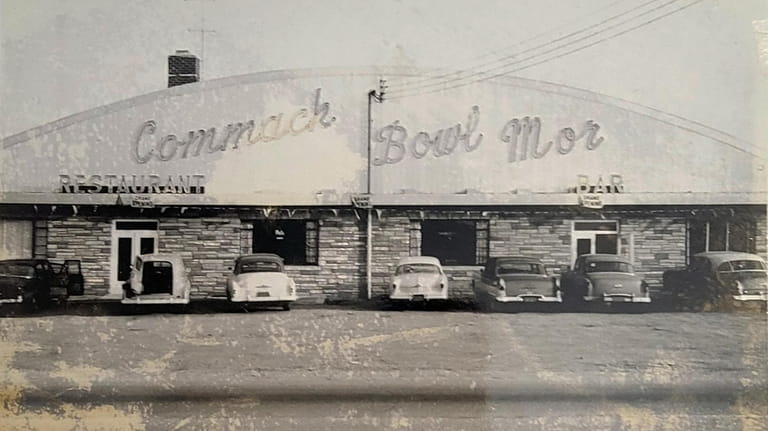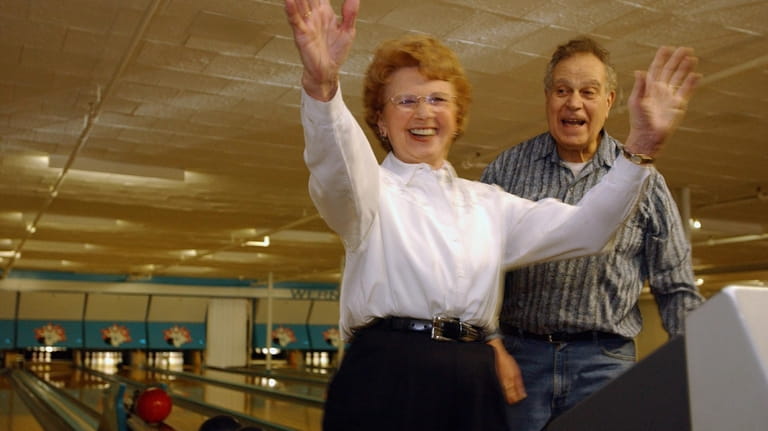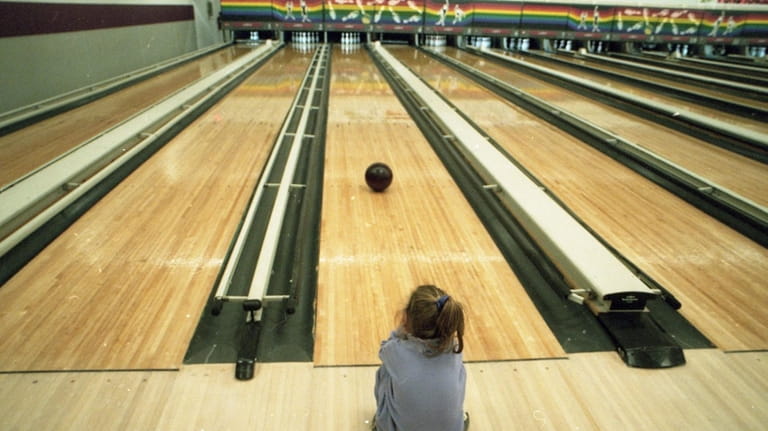Around 25 bowling alleys are left on Long Island. What happened to the ones we lost?
Bowling alleys once dotted Long Island like a chain of pearls, with a mom-and-pop place in practically every village and town. Even as late as 1985, there were 67 still in operation. Today? About 25 — 10 owned by two corporate chains.
In the 1960s, per industry reports, the nation had about 11,500 bowling alleys. Now there are only about 3,000. Blame changing tastes. More and different recreational options. Demographics, from the diminishing numbers of baby boomers who started as kids with league bowling and continued as adults, to the predominance of white-collar jobs, for which bowling alleys — once dubbed “the blue-collar country club” — are not the place to mingle and network.
Because bowling alleys in their heyday were not just a place of recreation, but a town hall of sorts. Some had a community room; some had a child care nursery. Local folks gathered for gossip, fundraisers, even betting on matches in their loud and lively living room away from home.
And Long Island was a nationally known hotbed of bowling. Lawrence’s Joe Falcaro and West Hempstead’s Andy Varipapa were the first bowling superstars, national champions who displayed dazzling trick shots in movie shorts and, with Varipapa, TV commercials. Proprietor Buddy Russell’s Garden City Bowl hosted several Professional Bowlers Association national championships in the 1960s, plus the PBA’s Long Island Classic from the mid-1970s to mid-1980s.
Bowling alleys likely won’t disappear, since they’ve changed with the times. A few old-fashioned ones remain. But the trend is toward glitzier all-around recreation centers, suitable for families by day and singles by night, with music, fancy cocktails and a club atmosphere.
But we remember the old places, because they represent a different world and a lost culture.
Mid-Island Bowl
265 N. Broadway, Hicksville
Opening Dec. 1, 1957, after launching for press the day before, Mid-Island Bowl was, like all, a family place. But one night a week it became one of the big “action houses” — a Damon Runyonesque place where a circuit of bowling bettors made it their regular stop. That included one later-to-be-famous musician.
“Monday nights would be Mid-Island Bowl, then Tuesdays would be Deer Park [Bowl, now Strike 10 Lanes Deer Park],” recounts Eddie Jablonski, 71, formerly of Hicksville and now of Summerlin, Nevada. Until becoming a coffee-truck owner-operator, he was a Professional Bowlers Association (PBA) part-time pro — and before that, a teenage bowling hustler.
“Wednesday wasn't much. Thursdays you could go to Kusky's in Baldwin or Green Acres [Bowl in Valley Stream]. Fridays we'd go to Syosset [Lanes]. Saturdays in the afternoon we'd go to Falcaro’s [Bowling Lanes] in Lawrence. And then Sunday morning was Farmingdale [Lanes].”
As he describes, “We would get a match going and there would be people in the back that didn't bowl. They would just bet on it. It might be 40, 50, sometimes more people looking to gamble on bowling.”
At Mid-Island in the late 1960s, Jablonski recalls, that included Hicksville youth Billy Joel, memorable as a local musician with the band The Hassles. “He used to come into the bowling alley to bet on the matches,” Jablonski remembers fondly. “I'm pretty sure he has one song where he references it, called ‘Easy Money’ ” — with the lyrics “Take me to the action / Take me to the track / Take me to a party if they’re bettin’ in the back.”
“That's what we used to call it: ‘betting in the back,’” Jablonski says. Joel’s representative did not respond to a request for comment.
The 48-lane alley closed in mid-1982. The site has since housed a Sleepy’s mattress store, a Petco and a Duane Reade.
Commack Bowl Mor
6190 Jericho Tpke., Commack
The unusual name of this 16-lane alley was because “my parents just wanted to be different,” explains Helen Pelkofski, whose father, Joe, and his brothers had been area farmers. After her parents “sold property on Burr Road to a developer, they had money, and everybody was going to Larkfield Lanes to bowl, and they just thought this was a good investment.”
They constructed a new building in 1954, and the whole family pitched in to help run Commack Bowl Mor. “My mother, Genevieve, was quite the businessperson. My dad was the personality,” Helen says. She and her siblings all helped out. “I worked the luncheonette counter with my mother,” recalls the 77-year-old retired construction-company owner, who lives in Mount Pleasant, South Carolina. Men downed boilermakers at the bar, and “The Commack High School teachers used to come in on Fridays with a league and bowl. And that was fun, to see the teachers not being teachers.”
In the 1970s, the Pelkofskis sold it to local bowling entrepreneur Bruno DiCapite and it became Bruno’s Commack Bowl. That closed in the early 2000s — and by July 2003, the building had been demolished to make way for a Commerce Bank.

Commack Bowl Mor, circa 1960s. Credit: Winckler Family Photo
Werner’s Bowl
9 W. Montauk Hwy., Lindenhurst
A previous incarnation, Werner’s Bowling, had been located at 806 Sunrise Hwy. in Baldwin since at least 1940. But 31-year-old David Wallach remembers the later Lindenhurst version as a welcome respite from the summer heat of day camp.
“Lindenhurst Village does a summer camp for residents, and I went between fourth and fifth grades,” says the health care industry worker, who still lives in the town. During that summer of 2003, “We did field trips out to Werner's as part of the day program. And that kind of got me into the sport. I thought bowling was great, and it was my favorite part of camp because I hated being outdoors then. I still do.” Amazingly, “They didn't have computerized screens there,” as was standard by then; scorekeeping “was pencil-and-paper. You had to do the calculations yourself.”
Wallach didn’t know then that it was the final year for Werner’s, which closed in 2004. “Everyone in the community was devastated,” he says, “that we were losing another small business to a corporation.” The alley was torn down, and a new building raised in 2008 to house an Advance Auto Parts.

Dorothy Messner, then 76, is congratulated by friend Ben Sottile, then 73, after bowling a strike at Werner's Bowling Alley in Lindenhurst in 2004. Credit: Newsday/Mayita Mendez
Meroke Lanes
2261 Merrick Rd., Merrick
Meroke — pronounced Mer-OH-kee — was a rare split-level alley, with half the lanes a level down and half a level up. Lasting from 1960 through 1988, it was one place where a teenager could go for that holy grail: beer.
“As kids in elementary school, our parents would drop us off and we could bowl all day,” remembers Daniel Pflieger, 48, originally from Merrick and now living in Portland, Oregon. At Meroke Lanes, “We learned that you can make free 1-900 phone calls from the pay phone, and we spent the time that we weren't bowling making prank calls.”
Ah, youth. The budding Bart Simpson went on to Calhoun High School but never strayed far from Meroke. “We learned the bar was very loose about checking IDs,” he says. “As 16-year-old kids we could play pool and drink beer and no one batted an eye, even though the drinking age was 21. We were well-behaved so they let us keep our secret.”
This being the early 1990s, “They had some of the cooler, more recent video games and we spent our allowances playing them. Fun times. It was a shame when they closed.” The site is now that of one Long Island’s three Greek Cove restaurants.

Woodbury Lanes
410 S. Oyster Bay Rd., Hicksville
Some old ads give the street address as 408, some as 440. New York State records give the address above. Whatever the number, it was all the same big, pitched-roof building at the corner of Woodbury Road, with a separate entrance for its bar and lounge, The Walnut Room. And whatever the number, it was a special place for Peter Baldwin.
Raised in Hicksville, “I was probably around 10, when I used to bowl there with my father,” says the 79-year-old retired appliance-company warehouse manager, who went on to bowl on a U.S. Army team and still rattles the pins at The All Star in Riverhead, where he now lives. His father, Arthur Baldwin Sr., who died in 1976, “was president for awhile of the Eastern Long Island Bowling Association, and I used to bowl with him in the CYO [Catholic Youth Organization] League at Woodbury.”
Before Woodbury Lanes opened in late 1955, Newsday’s Dick Clemente wrote of the high-tech, eagerly anticipated emporium, “It will have tele-score machines at each alley, two rows of spectator seats across the house, and a … promenade, carpeted, with chairs and tables. Telephones will be at every fourth alley, enabling patrons to call the desk … and even to make outside calls by going through the desk switchboard.”
Practically Vegas. But it wasn’t the modern amenities that gave the bowling alley, which closed in 1996, meaning for Baldwin.
“Out of six boys,” he says of his siblings, “I was the one that took up the bowling. My father was a pretty good bowler and we just hit it off in bowling.” Then after a pause he adds softly, “It was only thing we did together.”

Elizabeth Northcote, then 3, watches as her bowling ball slowly rolls down the lane at Woodbury Lanes in 1995. Credit: Newsday/David L. Pokress
Smithtown Bowl
200 Landing Ave., Smithtown
It’s hard to imagine now, but in the late 1950s and early 1960s, even star baseball players often had to hold offseason jobs or have outside business ventures. Yankees legend Yogi Berra famously drove a Coca-Cola truck, sold suits and opened a bowling alley in Clifton, New Jersey, with his teammate and fellow future Hall of Famer Phil Rizzuto.
So it’s no stretch that another future Hall of Famer Yankee, Whitey Ford, “had his own bowling establishment in Smithtown, New York,” as baseball historian Bill Morales wrote in “New York Versus New York, 1962: The Birth of the Yankees-Mets Rivalry.”
It’s unclear when Ford bought in or how big a stake he held in the 36-lane Smithtown Bowl. The alley was up and running by New Year’s Day 1959, and press reports mention “Whitey Ford’s Smithtown Bowl” as early as August 1961. Newsday in January 1962 also called it that, and paraphrased the pitching star in explaining a disappointing cancer fundraiser: “Most of the contingent of sports stars who were scheduled to appear were fogbound in New Jersey, according to Ford, and couldn’t make the show.”
The alley was sold to new owners Vinnie Auricchio and Joe Rynca in July 1963. It went through further proprietors, including George DiMatteo, who also owned other Long Island alleys, and lasted through September 2020. By that time it was owned by a corporation and renamed AMF Smithtown Lanes.
Yet somewhere in the 29,014-square-foot ghost that remained, the spirit of Whitey Ford still lingers in Smithtown.
